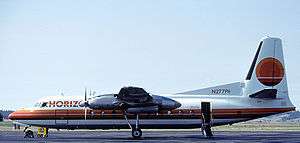Quebecair Flight 255
 A Fairchild F-27 similar to the aircraft involved in the accident | |
| Accident summary | |
|---|---|
| Date | 29 March 1979 |
| Summary | Engine separation |
| Site | Quebec City |
| Passengers | 21 |
| Crew | 3 |
| Fatalities | 17 |
| Survivors | 7 |
| Aircraft type | Fairchild F-27 |
| Operator | Quebecair |
| Registration | CF-QBL |
| Flight origin | Jean Lesage International Airport |
| Destination | Montreal |
Quebecair Flight 255 was a scheduled flight from Quebec City to Montreal. On March 29, 1979, the Fairchild F-27 registered CF-QBL operating the flight crashed after an engine exploded shortly after take off. All three crew and 14 of the 21 passengers died. The crash occurred minutes after it took off.
Crash
Following takeoff from Jean Lesage International Airport, the flight crew advised the control tower of a problem with their right engine. The plane was given clearance for an emergency landing, and it circled the airport twice, before flying above a restaurant with flames bursting from one engine. The plane had begun the final turn in its landing sequence, and crashed into a hillside. "I heard a loud explosion and rushed out and saw the plane in flames" one witness said. Firemen arrived at the scene within minutes, but it was reported they were "unable to approach the burning wreckage for some time because of the extreme heat." Ambulances had difficulty reaching the accident site because they had to cross a railway line to reach it. "Most of the people were not dead. Several died during the first half-hour after the accident. There were limbs cut off. We had to be careful when we were moving them," one woman told journalists.[1]
Investigation
The flight data recorders were recovered soon after the crash. Canadian investigators concluded that shortly after the twin-turboprop airliner lifted off the low pressure impeller from the no. 2 engine burst, causing the forward part of the no. 2 engine to separate. The flight crew were unable to raise the landing gear because debris from the engine damaged the electronic gear selection circuitry. This together with the exposed engine increased drag dramatically on the aeroplane, and the aircraft was unable to climb or maintain altitude during the final turn. The centre of gravity shifted beyond its aft limit due to the engine separation and passenger movement, causing the airspeed to drop below the minimum control speed shortly before the aircraft struck the hillside.[2]